
Understanding Eucalyptus Tree Roots: How to Manage Growth and Prevent Damage
Eucalyptus trees are beloved for their striking appearance and refreshing scent, but many gardeners worry about one hidden challenge: eucalyptus tree roots. These roots can spread aggressively, sometimes causing damage to nearby plants, structures, or plumbing. 
Table of Contents
ToggleWhat Are Eucalyptus Tree Roots? A Quick Overview 
Eucalyptus tree roots are the hidden heroes behind this fast-growing, iconic tree. But understanding them is key to managing their growth and preventing damage to your property. Here’s what you need to know in simple terms:
- Shallow but Spreading Roots
Unlike some trees with deep taproots, eucalyptus roots tend to grow wide and shallow. They spread close to the soil surface, often extending well beyond the tree’s canopy. This wide reach helps the tree absorb more water and nutrients but can also interfere with nearby structures like sidewalks, foundations, or underground pipes. - Fast Growth Means Aggressive Roots
Eucalyptus trees grow quickly — and so do their roots! This fast expansion means the roots can invade garden beds, drains, and even septic systems if left unchecked. Early awareness and control can save you costly repairs later. - Root System Types: Lateral and Sinkers
- Lateral roots spread horizontally and gather water and nutrients near the surface.
- Sinker roots grow downward, anchoring the tree and accessing deeper moisture.
Both types work together to keep the tree healthy and stable.
- Why Roots Matter for Your Property
Because of their size and speed, eucalyptus roots can cause cracking in pavements, lift patios, and even damage underground utilities. Understanding root behavior helps you plan where to plant and how to protect your property. - Quick Tip: Water Wisely
Eucalyptus roots thrive in moisture, so avoid overwatering near the tree’s base. Proper irrigation limits root expansion into unwanted areas.
By knowing these basics, you can take practical steps to manage eucalyptus roots effectively—keeping your tree healthy and your home safe!
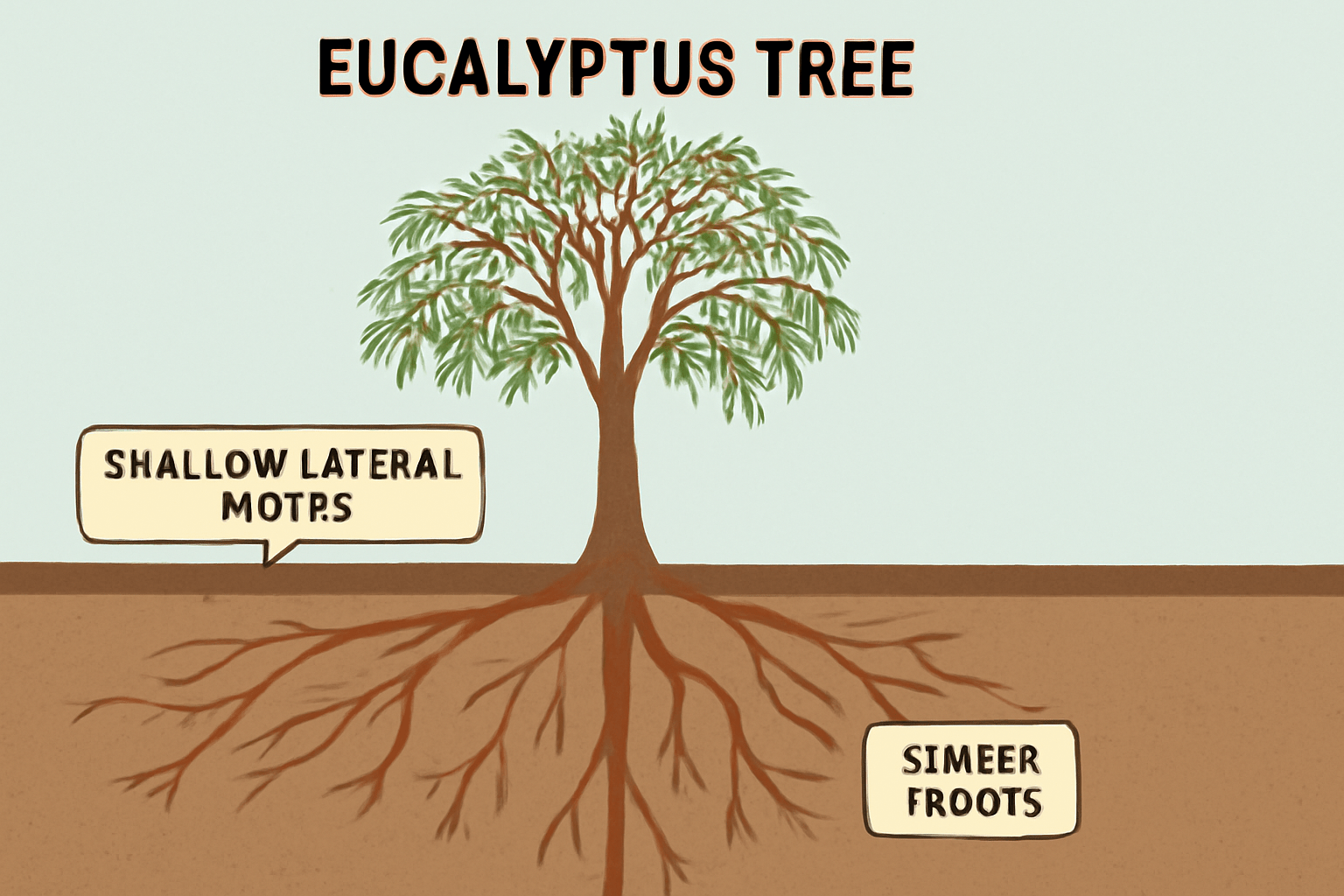
Common Problems Caused by Eucalyptus Tree Roots 

Eucalyptus trees are popular for their fast growth and beautiful appearance, but their roots can sometimes cause trouble if not managed properly. Understanding these common problems helps you protect your property and enjoy your tree safely.
1. Damage to Foundations and Structures 

Eucalyptus roots grow aggressively and can spread wide and deep in search of water. When planted too close to buildings, they may invade foundations, causing cracks or uneven settling. This can lead to costly repairs and structural instability.
Tip: Always plant eucalyptus at least 15–20 feet away from houses or any permanent structure.
2. Interference with Underground Pipes and Sewers 

Roots naturally seek moisture and can infiltrate sewer lines, water pipes, or drainage systems. This often results in clogged pipes, leaks, or blockages that disrupt plumbing and cause unpleasant odors or flooding.
Tip: Avoid planting near underground utilities and have regular inspections to catch issues early.
3. Uplifting and Cracking of Pavements and Driveways 

The powerful growth of eucalyptus roots can lift and crack concrete, asphalt, or paving stones. This creates uneven surfaces that are hazardous to walk or drive on and expensive to repair.
Tip: Use root barriers or flexible pavement materials near eucalyptus trees to minimize damage.
4. Competition for Water and Nutrients 

Eucalyptus roots absorb a lot of water and nutrients, which can stress nearby plants or grass. This can lead to poor lawn health or struggling garden plants, especially in dry climates or during drought.
Tip: Mulch around the tree base and water surrounding plants deeply to reduce competition.
5. Difficulty in Removal or Transplanting 

Because eucalyptus roots spread wide and can be very deep, removing or transplanting mature trees is challenging. If roots are cut improperly, the tree may become unstable or die, creating safety risks.
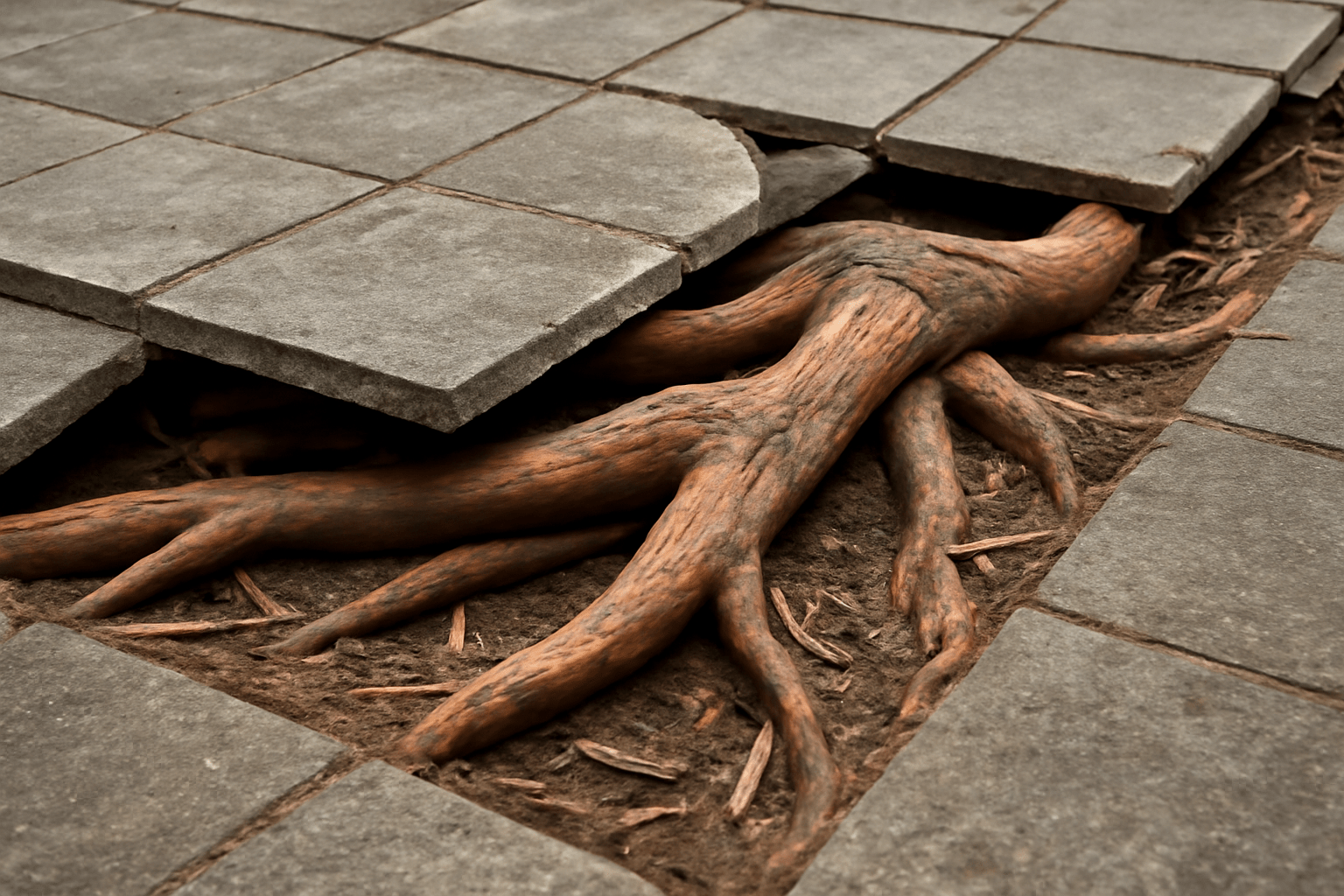
How to Identify If Your Eucalyptus Tree Roots Are Causing Problems 

Eucalyptus trees are beautiful and fast-growing, but their roots can sometimes cause issues if left unchecked. Knowing the signs early can save you from costly repairs and protect your landscape. Here’s how to spot if your eucalyptus tree roots are causing problems — explained in a simple, practical way!
1. Cracks or Uplifting in Pavements and Driveways 
If you notice cracks, bumps, or lifted sections in nearby sidewalks, driveways, or patios, eucalyptus roots might be pushing up beneath the surface. These roots grow close to the soil surface and can exert pressure on hard surfaces, causing unevenness or damage.
What to do: Mark the affected areas and check if they align with the location of your tree. Avoid heavy loads near these spots until you address the root issue.
2. Plumbing or Drainage Issues 
Roots love moisture, so they often invade underground pipes searching for water. If your drainage slows down, or you experience frequent blockages and pipe bursts, eucalyptus roots might be the culprit.
What to do: Hire a professional plumber to inspect your pipes with a camera. Early detection can help prevent costly repairs.
3. Cracks in Walls or Foundations 
Roots growing under or near your home foundation can cause cracks in walls or floors due to soil movement and pressure. If you spot new or expanding cracks near the base of your house, roots could be disturbing the soil stability.
What to do: Consult a structural expert and consider root barriers or professional root pruning to protect your foundation.
4. Wilting or Yellowing Nearby Plants and Lawn 
If your garden or lawn near the eucalyptus tree looks unhealthy, wilting, or yellow, the tree’s roots might be competing for water and nutrients, or damaging irrigation lines.
What to do: Water affected plants more deeply and monitor if symptoms improve. Consider installing root barriers to protect your garden beds.
5. Visible Roots Above Ground or Bulging Soil Mounds 
Healthy eucalyptus roots are usually underground, but if you see thick roots exposed on the surface or soil mounds forming near the tree base, it means roots are spreading aggressively and may be causing soil upheaval.
What to do: Avoid cutting exposed roots yourself — call an arborist to assess and prune safely without harming the tree.
6. Tree Leaning or Unstable Base 

A tree that suddenly leans or feels unstable may have root problems like rot, damage, or uneven growth. This is a serious sign that the root system isn’t supporting the tree properly.
What to do: Contact a certified arborist immediately to evaluate the risk and recommend treatment or removal if necessary.
Quick Tips to Monitor Your Eucalyptus Roots Regularly:
- Walk around your tree monthly, checking for any new cracks, bumps, or exposed roots
- Keep an eye on the health of nearby plants and lawn
- Watch for any changes in drainage or plumbing performance
By recognizing these warning signs early, you can manage your eucalyptus tree’s roots effectively, preventing damage and keeping your outdoor space safe and beautiful.
If you’re ever unsure, don’t hesitate to get a professional opinion—prevention is always easier and cheaper than repair!
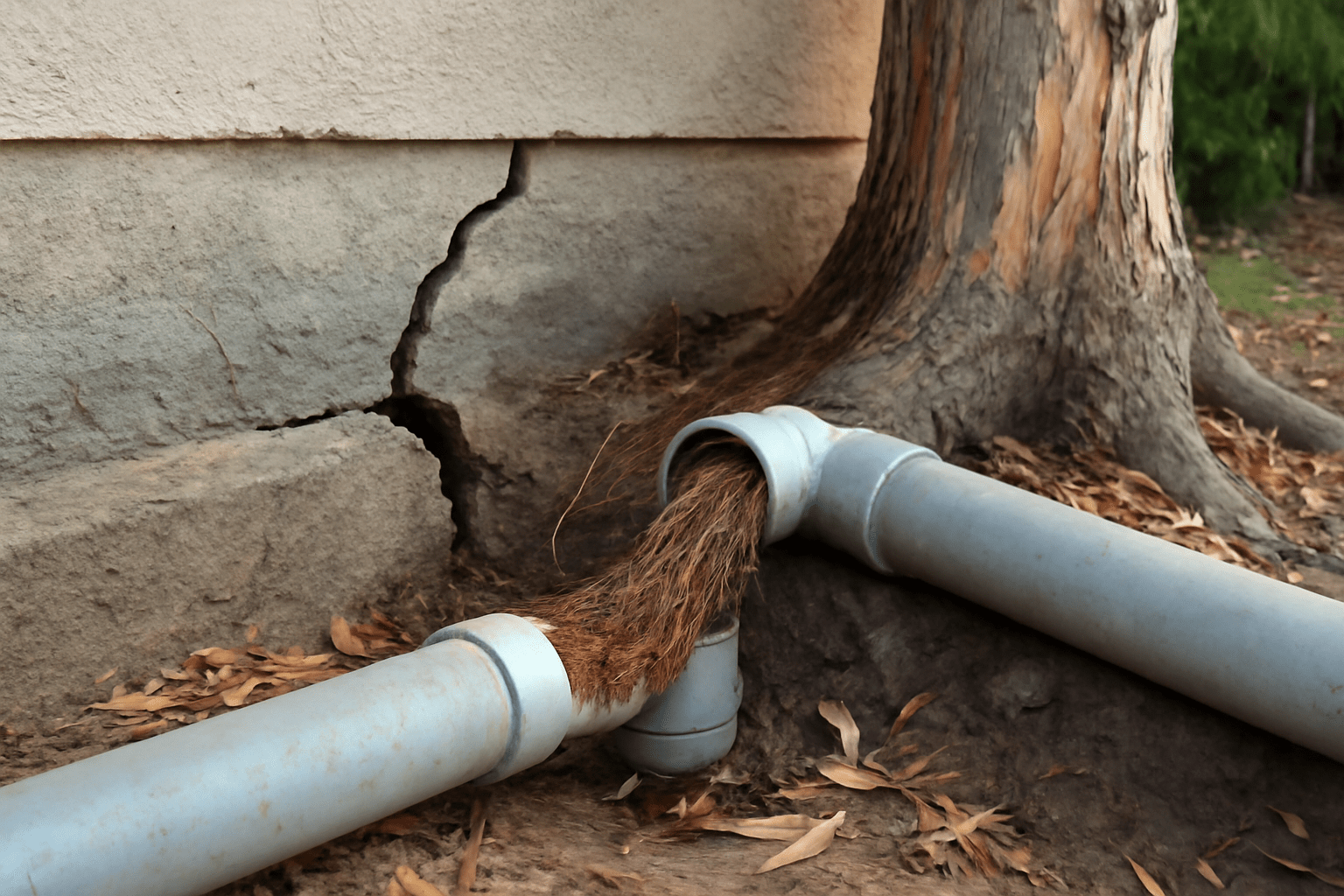
Best Practices to Manage and Control Eucalyptus Tree Roots 

Eucalyptus trees are beautiful and fast-growing, but their roots can sometimes cause problems—cracking sidewalks, invading pipes, or spreading aggressively. The good news? You can manage and control eucalyptus roots effectively with a few smart steps. Here’s how:
1. Choose the Right Planting Location
Start by planting your eucalyptus tree at a safe distance from buildings, sidewalks, and underground pipes. A minimum of 15-20 feet away helps prevent root-related damage. Roots naturally seek moisture and space, so giving them plenty of room to grow reduces risks.
2. Use Root Barriers to Guide Growth
Installing physical root barriers—like sturdy plastic or metal sheets—can direct roots downward instead of spreading laterally. Place barriers vertically around the root zone when the tree is young to guide root growth away from vulnerable areas like foundations or drains.
3. Regularly Prune Roots and Branches
Pruning isn’t just for branches. Periodic root pruning, done carefully, helps keep the root system manageable. It’s best performed by professionals who can avoid harming the tree while cutting back invasive roots. For branches, trimming encourages healthier growth and reduces water demand, limiting aggressive root spread.
4. Maintain Proper Watering Practices 
Eucalyptus roots grow toward water sources. Overwatering or leaks near the tree can encourage roots to expand dangerously. Water your tree moderately and fix any irrigation leaks nearby. This discourages roots from invading pipes or foundations in search of moisture.
5. Monitor and Inspect Regularly
Keep an eye on your eucalyptus tree’s surroundings. Look out for cracked pavement, raised soil, or blocked drains, which could signal root intrusion. Early detection lets you address root problems before they cause serious damage.
6. Consider Root-Resistant Varieties
If you’re planning to plant a eucalyptus tree, research varieties known for less aggressive root systems. Some species have naturally less invasive roots, making them better suited for gardens close to homes or infrastructure.
7. Consult an Arborist for Complex Situations
If you notice signs of root damage or have a large eucalyptus tree near structures, consulting a certified arborist is wise. They can assess the situation and suggest tailored root management strategies like professional root pruning, soil treatment, or alternative tree care solutions.
By following these best practices, you’ll enjoy the beauty and benefits of your eucalyptus tree without worrying about root-related headaches. 
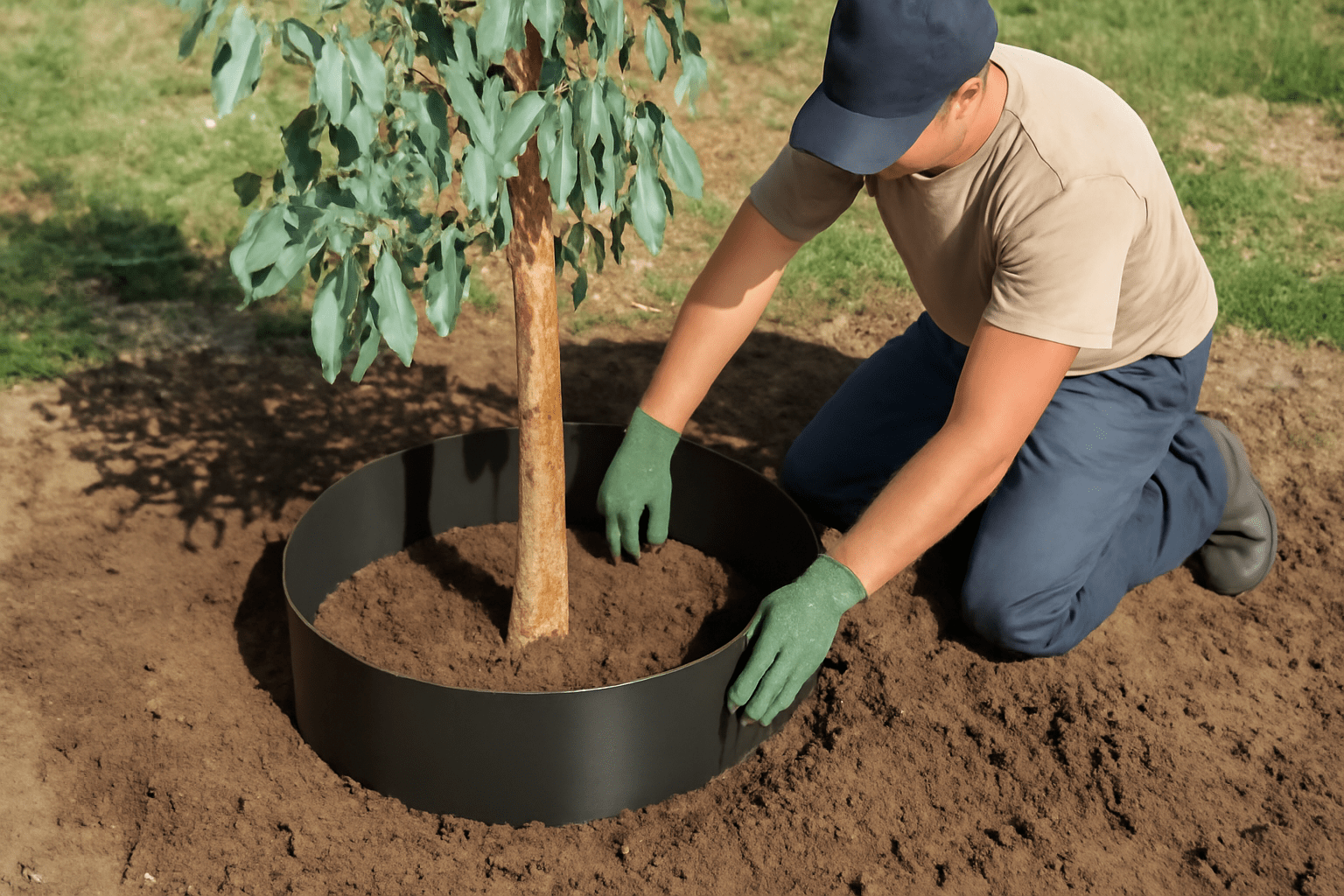
When and How to Safely Remove or Transplant Eucalyptus Trees
Eucalyptus trees are beautiful and fast-growing, but sometimes they need to be relocated or removed due to issues with their roots or their impact on nearby structures. Knowing when and how to safely remove or transplant eucalyptus trees is key to ensuring both the health of the tree and the safety of your property. Here’s your guide to doing it the right way.
When to Remove or Transplant Eucalyptus Trees
- Roots Causing Damage
If you notice the roots are pushing against foundations, pipes, or sidewalks, it’s time to consider moving the tree. Eucalyptus roots can be invasive and may cause serious damage to surrounding structures. Transplanting to a safer location can help prevent this problem. - Tree Health Decline
If the tree is unhealthy or diseased, removing it may be the best option to prevent the spread of pests or infections to other plants in the area. Look for signs like yellowing leaves, dead branches, or peeling bark. If the tree isn’t thriving, it might be a sign it’s time for a move. - Overcrowding
If your eucalyptus tree is too close to other trees or your home, it may not be getting the light or space it needs to grow properly. Transplanting the tree can help it flourish in a new spot with more room. - Before Severe Weather
If your area is prone to strong winds or storms, and your eucalyptus tree is large or top-heavy, consider removing or transplanting it before the weather takes a toll. Strong winds can uproot or break branches, causing damage to nearby property.
How to Safely Remove or Transplant a Eucalyptus Tree
Step 1: Assess the Tree’s Size and Health
Before you do anything, make sure the tree is in good health for transplanting. If it’s large and healthy, you’ll need professional help. A smaller, younger tree is easier to transplant on your own. Use a shovel or hand tools to check the root system and determine if it’s feasible to move.
Step 2: Timing is Crucial
The best time to transplant or remove a eucalyptus tree is during the dormant season (late fall or early spring), when the tree is not actively growing. This minimizes stress on the tree and increases its chances of survival after being moved.
Step 3: Prepare the New Location
Choose a new spot with plenty of sunlight and room for the eucalyptus to spread. Make sure the soil is well-draining and not too close to structures, pipes, or sidewalks. Dig a hole that is at least twice the size of the tree’s root ball to give the roots plenty of space to grow.
Step 4: Digging the Tree Out
Carefully dig around the root system, keeping as much of the root ball intact as possible. If the tree is large, this may require professional equipment like a tree spade. Gently lift the tree from the ground and wrap the root ball in burlap or plastic to protect it during transport.
Step 5: Transplant or Remove the Tree
- For Transplanting: Place the root ball in the new hole and cover with soil. Water the tree thoroughly and add mulch around the base to help retain moisture. Keep the tree well-watered for the first few weeks to ensure it takes root.
- For Removal: If you’re removing the tree completely, cut back any large branches before taking down the trunk. Hire professionals for large trees to avoid injury or property damage. Once the tree is gone, take steps to deal with the stump and remaining roots to prevent regrowth.
Step 6: Aftercare
Whether transplanted or removed, care for the site afterward. Water the new tree regularly and monitor its health. If you removed the tree, fill the hole with soil, and keep the area clear of debris to prevent new growth.
Important Tips 
- Professional Help: If the tree is large or in a tricky location, always call in professionals. Their expertise and equipment will ensure the tree is removed or transplanted safely.
- Safety First: Wear protective gear, including gloves and safety glasses, when working with large trees. Always be cautious of falling branches or uneven ground.
- Be Patient: It can take time for a transplanted eucalyptus to establish itself. Be patient and provide consistent care to help it thrive in its new home.
By following these guidelines, you’ll be able to safely remove or transplant your eucalyptus tree with minimal stress to both the tree and your property.
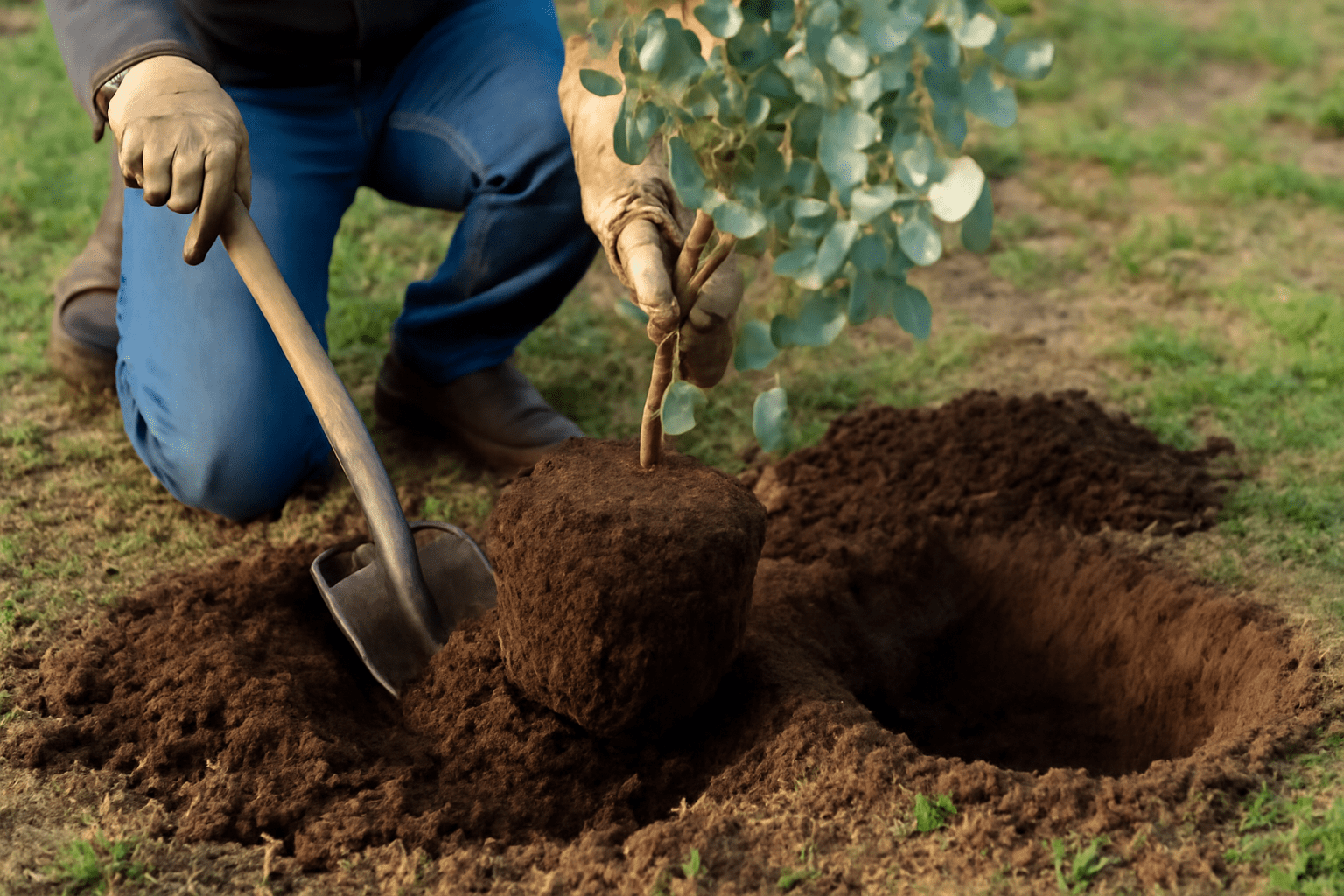
Pro Tips for Maintaining a Healthy Eucalyptus Tree and Garden 
Eucalyptus trees are known for their vibrant foliage, aromatic leaves, and fast growth. However, maintaining a healthy eucalyptus tree in your garden requires the right care and attention. Whether you’re planting a new tree or nurturing an existing one, these practical tips will help ensure your eucalyptus thrives without causing damage to your garden or property.
1. Choose the Right Location 
Eucalyptus trees love the sun and prefer well-drained soil. When planting, choose a location that receives full sun (at least 6 hours of direct sunlight daily). Ensure the soil is not too compact, as eucalyptus roots need room to spread.
2. Water Properly 
While eucalyptus trees are drought-tolerant, they do need water during their early years to establish deep roots. Water deeply but infrequently, allowing the soil to dry out between waterings. Avoid over-watering, as it can lead to root rot. Once established, your eucalyptus will need less water.
3. Mulch to Retain Moisture 
Mulching around the base of your eucalyptus tree helps retain moisture and suppress weeds. Use organic mulch, such as wood chips or bark, but make sure to leave some space around the trunk to prevent fungal infections. Aim for a 3-inch layer to keep the soil moist during dry spells.
4. Prune Regularly 
Pruning is key to maintaining a healthy eucalyptus tree. Trim dead or damaged branches regularly to promote strong, healthy growth. Light pruning can also help shape the tree and prevent it from becoming too large for its space. Be sure to prune in late winter or early spring before the growing season begins.
5. Watch Out for Pests and Diseases 
Eucalyptus trees can attract pests like aphids, scale insects, and eucalyptus weevils. Check your tree regularly for signs of infestations, such as discolored leaves or sticky residue. Use organic insecticides or neem oil to treat any pest problems. Additionally, monitor for fungal diseases and remove any affected branches promptly.
6. Control Root Growth 
Eucalyptus trees have extensive, fast-growing roots that can damage nearby structures and other plants. To manage root growth, consider planting your tree in a root barrier or container if space is limited. Regularly monitor the tree’s root system, especially if planted near foundations, sidewalks, or pipes.
7. Fertilize Sparingly 
While eucalyptus trees aren’t heavy feeders, they can benefit from occasional fertilization, especially if your soil is poor. Use a balanced, slow-release fertilizer in the early spring. Avoid over-fertilizing, as this can cause excessive growth and make the tree more susceptible to pests.
8. Prevent Damage from Wind 
Due to their height and fast growth, eucalyptus trees can be vulnerable to wind damage. Planting them in areas with natural windbreaks (such as fences or taller shrubs) can help protect them from strong winds. If you’re planting a new tree, consider staking it for the first year to help it establish a strong trunk.
9. Monitor Soil pH 
Eucalyptus trees thrive in slightly acidic to neutral soils (pH 6-7). Regularly test the soil pH to ensure it’s in the optimal range. If your soil is too alkaline, you can add sulfur to lower the pH and create a more favorable environment for your eucalyptus.
10. Prevent Invasive Spread 
Eucalyptus trees can become invasive in certain climates, spreading through seeds or root suckers. To control this, remove any new growth from the base of the tree and regularly check for seedlings around the area. Preventing uncontrolled spread ensures that your eucalyptus won’t compete with other plants for resources.
With these simple yet effective tips, your eucalyptus tree will thrive and stay healthy, providing beauty and shade without causing damage. 
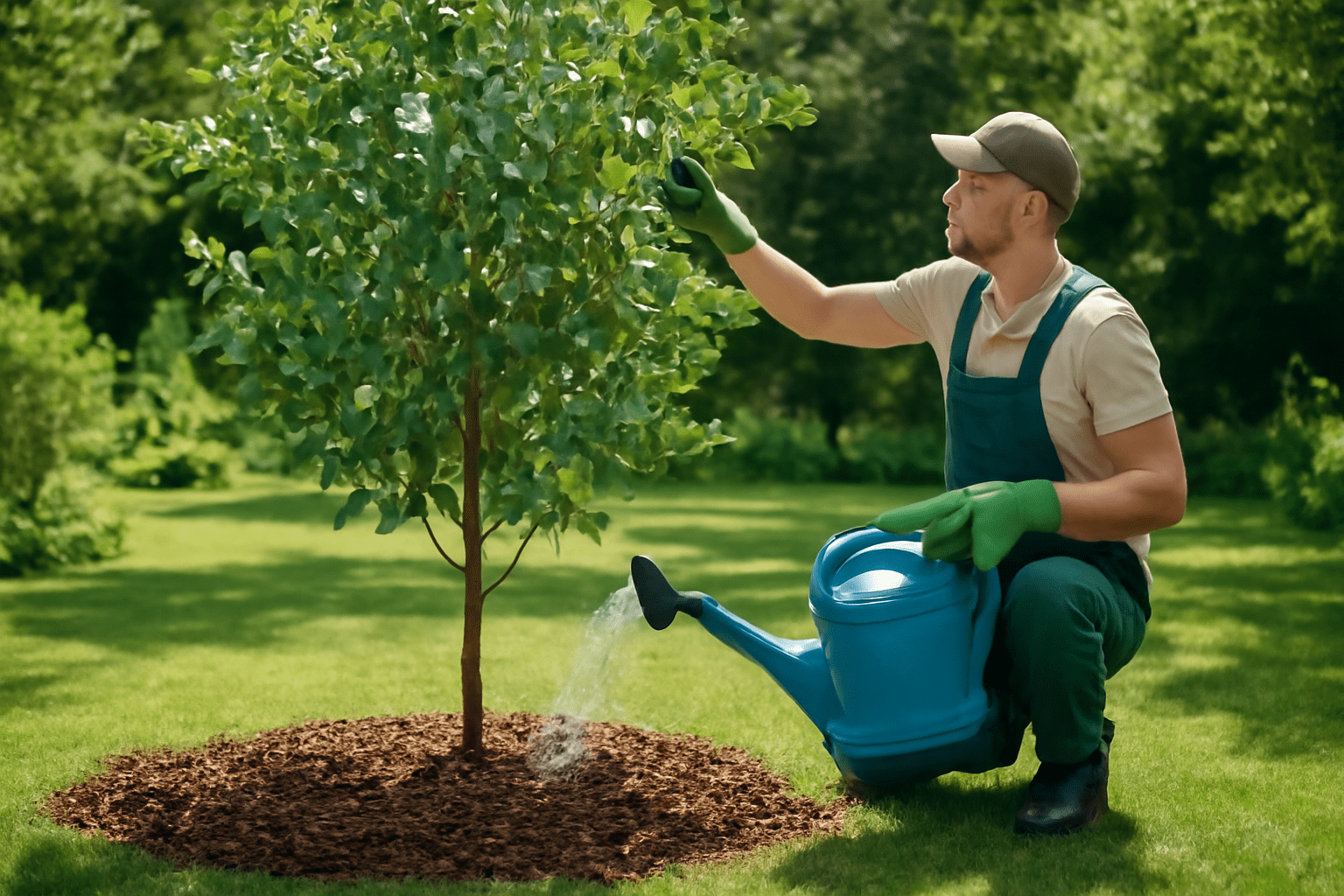
Conclusion 
Understanding and managing eucalyptus tree roots is essential for keeping both your tree and your garden safe and healthy. By being proactive with planting, monitoring, and using techniques like root barriers, you can prevent common problems like damage to structures and competing with nearby plants. Regularly checking root growth and responding early can help ensure that your eucalyptus tree remains a beautiful, low-maintenance feature in your landscape for years to come
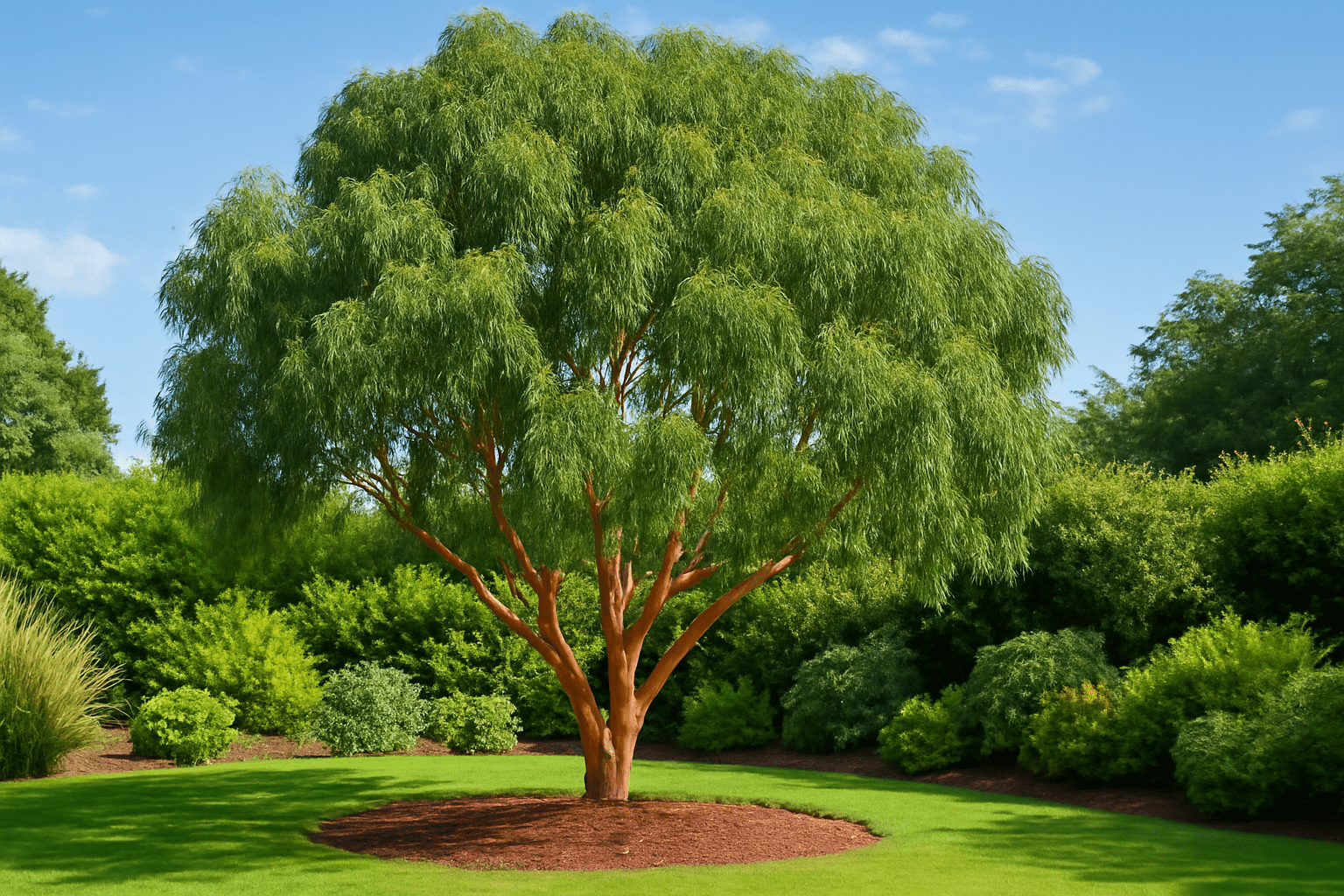
By applying the tips and strategies outlined in this article, you can confidently manage your tree’s root system, avoiding damage while allowing your eucalyptus to thrive. With proper care and attention, you’ll enjoy the many benefits of eucalyptus trees without the hassle of root-related concerns!
Frequently Asked Questions (FAQs)
How deep do eucalyptus tree roots grow?
Eucalyptus tree roots generally spread out near the surface but can also develop a deep taproot, especially in mature trees. The root system tends to spread widely, sometimes extending several meters from the tree, which can cause issues if planted too close to structures.
Do eucalyptus roots damage foundations or pipes?
Yes, eucalyptus tree roots are known for being aggressive and can damage foundations, sewer lines, and underground pipes. It’s important to plant them far from your home or use root barriers to prevent damage.
How far should I plant a eucalyptus tree from my house?
To prevent root interference, plant a eucalyptus tree at least 15-20 feet away from your house. This allows the tree enough space for healthy root growth while minimizing the risk of damage to your home.
Can eucalyptus roots harm other plants in my garden?
Yes, eucalyptus roots can outcompete nearby plants for water and nutrients, especially if planted too close. It’s best to give your eucalyptus plenty of space, and consider using root barriers if planting in crowded garden spaces.
What are root barriers, and how do they help?
Root barriers are physical barriers installed in the soil around the tree to prevent roots from spreading too far. They help contain root growth, redirect it away from structures, and minimize competition with nearby plants, making them a valuable tool for managing eucalyptus roots.
How can I prune eucalyptus tree roots safely?
Root pruning should be done carefully to avoid damaging the tree. Only prune roots in the top 12-18 inches of soil, and avoid cutting more than 25% of the root system. It’s best to do this when the tree is dormant, typically in late winter or early spring.
Will eucalyptus roots cause problems if grown in a pot?
Eucalyptus trees can be grown in pots, but their roots may outgrow the container if not monitored. Make sure the pot has good drainage, and repot every couple of years into a larger container to prevent root crowding and ensure healthy growth.
How can I prevent eucalyptus tree roots from damaging my garden or lawn?
To prevent damage, plant eucalyptus trees away from other sensitive plants, use root barriers, and regularly monitor root growth. Avoid overwatering, as this can encourage excessive root spread. Keeping the soil healthy and well-drained also helps control root expansion.




